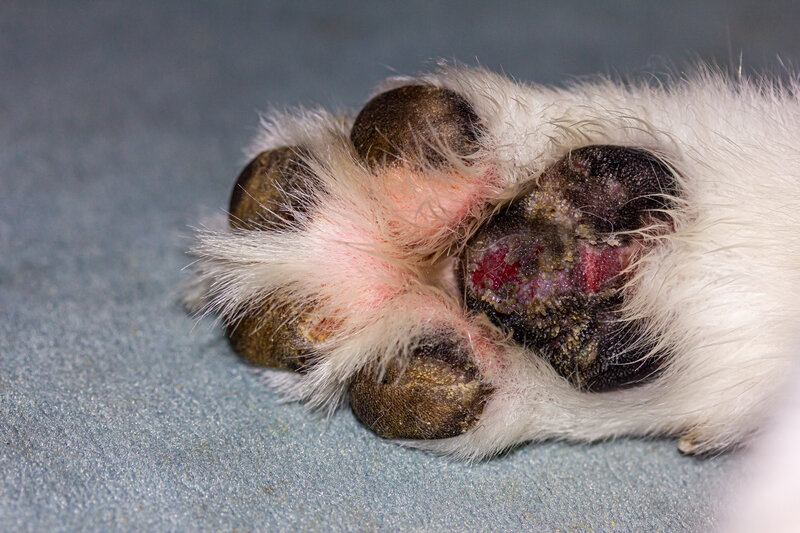- February 25, 2024
Why Are My Dogs Feet Red? 4 Vet Reviewed Causes



The information is current and up-to-date in accordance with the latest veterinarian research.
Perhaps you notice that your dog is favoring one leg. Maybe your pup is licking their paws frequently. When you finally look at their feet, you see they are red and swollen. Pododermatitis describes the inflammation and immune response you’ve observed in your pet. Your next question is, undoubtedly, what’s causing it, and what can you do?
Pododermatitis is not diagnostic of itself. It’s a sign that something is wrong, but it can have many, varied causes. They can range from benign to severe. This condition may exist alone or accompanied by other indicators. You should immediately take your pup to the vet if they are bleeding, struggling to breathe, or crying out in pain or distress. Let’s discuss what can cause red feet in canines.

The 4 Causes of Red Paws in Dogs
1. Injuries
If only one paw is affected, the chances are it might be an injury. It may have occurred suddenly when your dog stepped on something sharp or sprained it on uneven terrain. It could also be something stuck between your pet’s paw pads that’s causing pain. If your pet will let you, examine the affected paw for any apparent injury or irritation.
Another potential cause is irritation or burns from either too cold or warm surfaces. Dogs can get frostbite from prolonged contact with the cold. Likewise, hot concrete can hurt your pet’s paws. Other seasonal hazards include ice formation between your pup’s pads or salt used to melt ice. We recommend early morning or evening walks if the weather is inclement to prevent recurrences.
2. Infections
Fungi, yeast, and bacteria can all cause painful infections, leading to red paws. These conditions trigger an immune response in your pet. They’re often accompanied by other signs, such as heat or swollen paws. You may see open sores, scabs, or a discharge, particularly if your dog is licking their feet constantly. You may even notice hair loss around the site of the infection.
They can occur on their own or result from a secondary bacterial infection from an existing wound. These issues require a visit to the vet to determine the underlying cause and treatment plan. They will get a medical history and collect skin scrapings or cultures to pinpoint the problem.

3. Allergies and Parasites
Allergies can often appear during spring and summer due to certain plants or grasses. If you notice a recurring issue, that may point to the cause. Parasites can also cause red feet. Highly sensitive pets may develop flea allergy dermatitis. These problems require prompt treatment. After all, your pet is uncomfortable.
Food allergies and atopy can trigger a reaction, urging your dog to lick their itchy feet, causing redness. These pets may also have hair loss, ear infections, and other signs of irritation. These conditions are notoriously challenging to diagnose and treat. The fact that a reliable test doesn’t exist complicates matters. Treatment involves an elimination diet to identify the problem.
4. Genetics and Age Factors
Some breeds are prone to certain skin conditions that can cause red feet. For example, one study found that West Highland White Terriers and Pekingese are susceptible to developing interdigital cysts. They often develop as a result of an environmental irritant, leading to excessive licking. After ruling out other conditions, your vet will likely put your pet on oral medication and work with you to determine their cause.
Likewise, other breeds are predisposed to other skin conditions that can affect their feet. English Bulldogs and Chinese Shar-Peis commonly experience issues with their skin folds and short coasts. Sometimes, age plays a role. Canine demodicosis occurs in dogs over 4 years old. Populations of Demodex canis mites that usually exist explode, leading to occasionally severe infestations.


Other Potential Causes
Pododermatitis can have other seemingly unexpected causes involving the immune or endocrine system. Hypothyroidism is one potential source. It can also point toward liver disease or a cancerous growth with nail bed squamous cell carcinoma. The takeaway is that your dog’s red feet may be a sign of irritation and not a significant cause for concern. However, it can also be a red flag worth investigating.
Therefore, it’s imperative to rule out other problems, especially if your pup shows other signs of an issue, such as lesions, open sores, nodules, or an impact on your dog’s quality of life. Of course, the treatment and prognosis depend on the underlying condition.
We suggest getting your pet used to having their paws handled. Regular nail trimming can ensure you can easily inspect your pup’s feet for potential problems. We also suggest wiping your dog’s paws after you bring them inside the house after playtime or walks. Early detection of an irritant or sign of an infection can make your pet’s recovery easier and quicker.


Final Thoughts
Your dog’s red feet may simply be a reaction to an irritant or a pebble between their pads. However, it can also be a warning sign that something else is wrong. We recommend regularly inspecting your pet’s feet. If you notice other issues, such as limping or an unusual gait, make an appointment with your vet. Prevention and early detection are your pup’s best friends.
Featured Image Credit: Oksamutnaya, Shutterstock
Tags
What do you think?
Related Articles

New Puppy Checklist: Gear You’ll Need for Your New Dog
Getting a new puppy is really exciting, but before you welcome them home, it’s important to prepare your space for them. Since puppies need a

How Big Do Mini Poodles Get? Vet Reviewed Average Weight & Growth Chart – Dogster
The information is current and up-to-date in accordance with the latest veterinarian research. Learn more » When you buy a Miniature Poodle, you might not

Can Police Dogs Smell Nicotine? Vet Verified Facts & Info – Dogster
The information is current and up-to-date in accordance with the latest veterinarian research. Learn more » While cigarette sales have been declining steadily for decades,

How Old Is 5 in Dog Years? Vet-Approved Guide to Each Size of Dog – Dogster
The information is current and up-to-date in accordance with the latest veterinarian research. Learn more » A common method for calculating a dog’s age is

